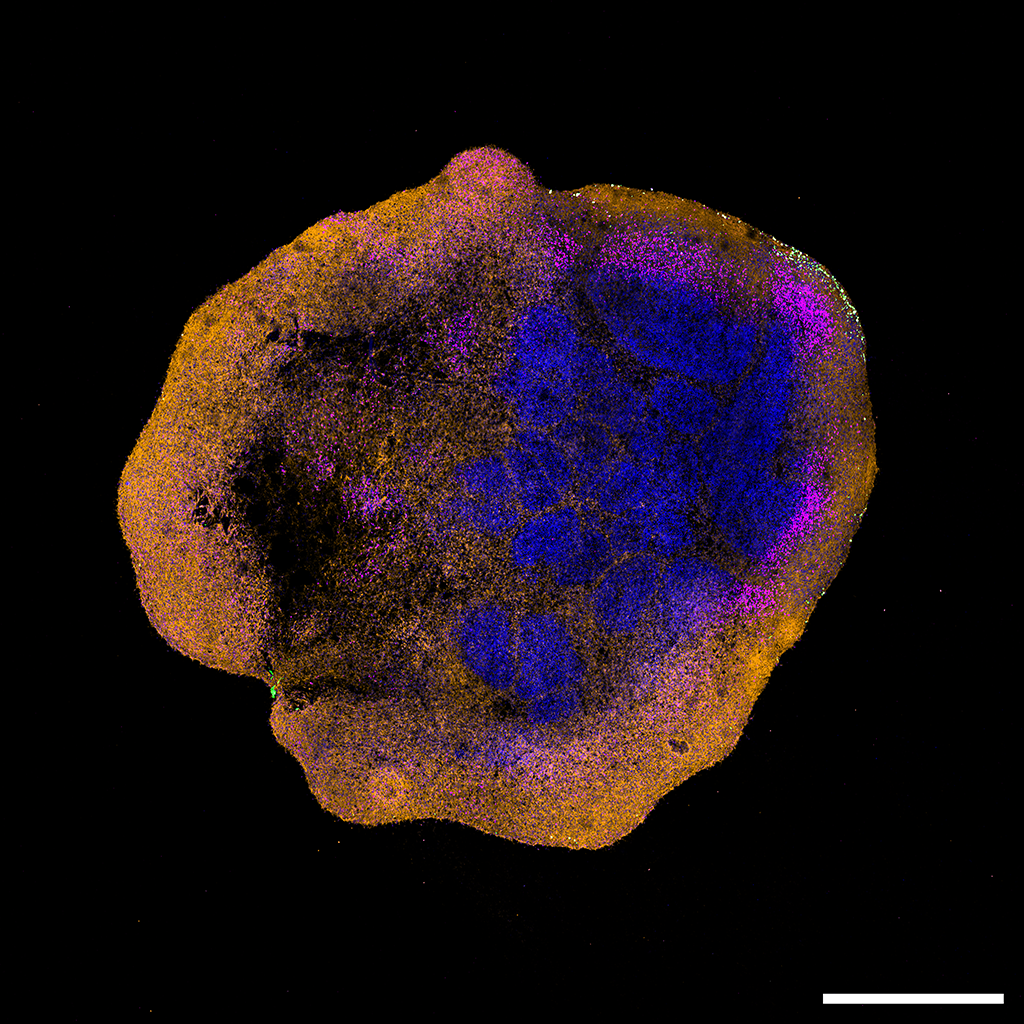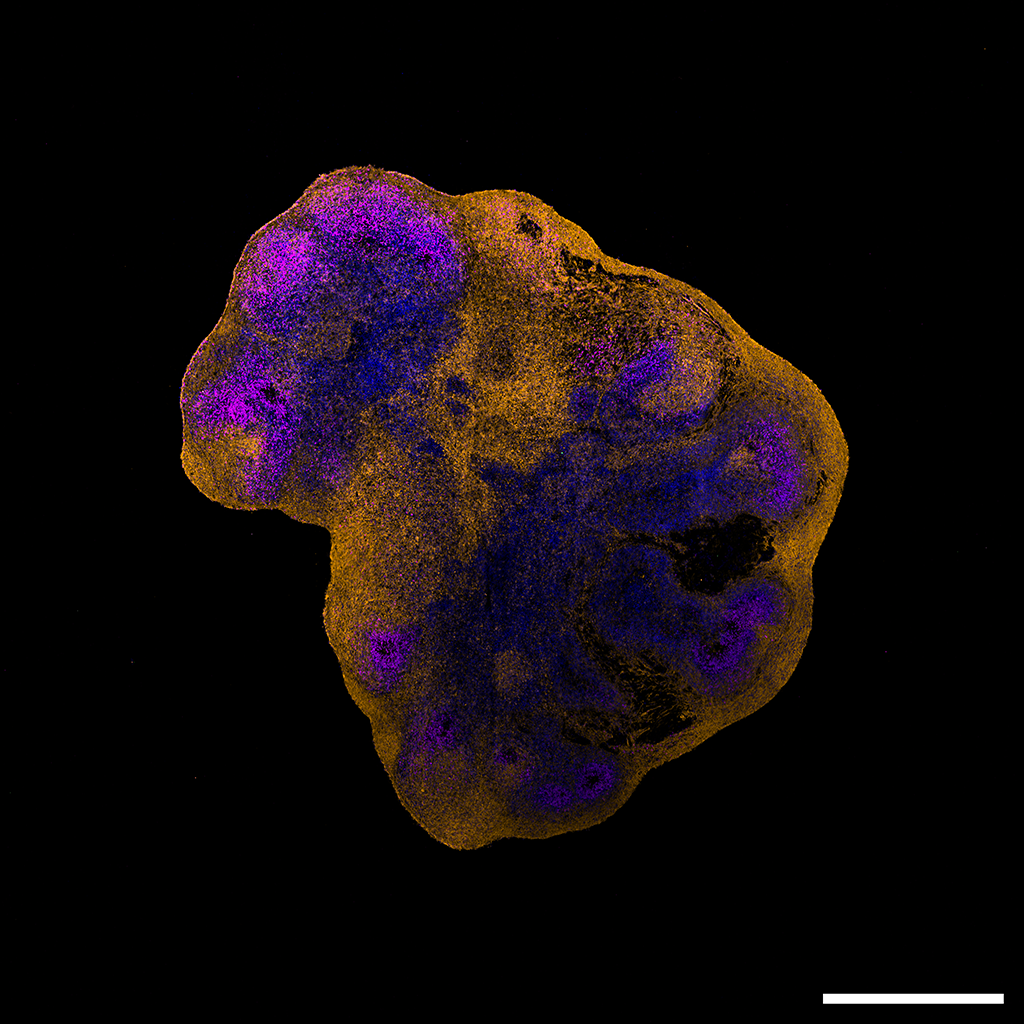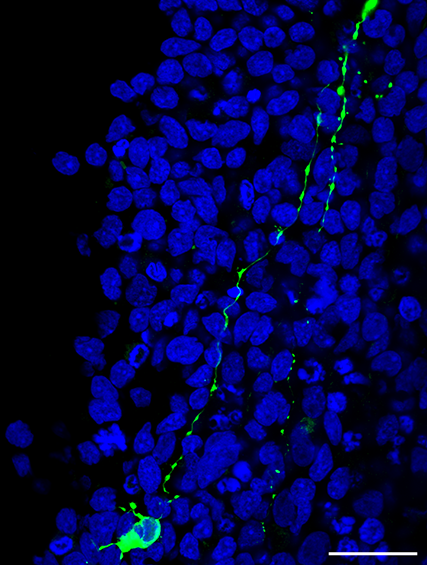Can the monkeypox virus infect the human brain?
A new study led by researchers from the Institute of Virology and Immunology (IVI) and the University of Bern in collaboration with the Lausanne University Hospital and the Spiez Federal Laboratory shows that the monkeypox virus can spread efficiently in brain organoids, causing neuronal cell death. The study provides important insights into a previously unexplored aspect of MPXV infections.
The monkeypox virus (MPXV) can spread from animals to humans and between humans, causing the disease mpox. In recent years, MPXV has evolved into two distinct genetic groups, known as “clades”. While clade I predominantly occurs in Central Africa, clade II of the MPXV was reported for the first time in over 100 countries worldwide, including Switzerland, in summer 2022. Moreover, since September 2023, the World Health Organization (WHO) reported an increase of a new MPXV sub-variant (clade Ib) in the Democratic Republic of Congo, which has recently spread to several neighboring countries. Consequently, in August 2024, the WHO declared this epidemic a "public health emergency of international concern". Although the symptoms of mpox are generally mild, often including flu-like symptoms and rash development, complications can occur. Between 1985 and 2021, approximately 3% of individuals infected with MPXV developed neurological symptoms such as seizures or encephalitis, with some cases being fatal. Yet, the extent to which the MPXV affects the human central nervous system remains poorly understood.
A team of researchers from the Institute of Virology and Immunology (IVI) and the University of Bern, in collaboration with the Lausanne University Hospital and the Spiez Federal Laboratory, has demonstrated for the first time that the MPXV can efficiently spread from cell to cell in brain organoids, leading to neuronal cell death. The study, supported by the Multidisciplinary Center of Infectious Diseases (MCID) at the University of Bern, was recently published in the journal Nature Communications.
Brain organoids: a promising model for studying neurological disorders
Prior to this study, neurological manifestations had already been reported in patients with MPXV infection. In animal studies, viral components were also detected in the brain of infected animals. However, the mechanisms underlying these neurological symptoms have remained largely unexplored. “This is likely because the virus was, for a long time, geographically restricted and there were few available samples and models to investigate its impact on the nervous system”, says Prof. Dr. Marco Alves from the IVI and the University of Bern, last author of the study.
The team of researchers used innovative human brain organoids to study how the MPXV spreads in the brain. “Brain organoids are 3D tissue models generated from human pluripotent stem cells. As they mature into neural tissue, they form structures that recapitulate specific brain features. Although complex to generate, brain organoids hold enormous potential for studying neurological diseases” explains Isabel Schultz-Pernice, PhD student at the IVI and the University of Bern and first author of the study. The cultivated organoids were then exposed to a virus sample isolated from a patient infected during the 2022 outbreak. “Using advanced imaging techniques, we were able to observe how MPXV spreads within these neuronal cells” she adds. “These experiments would have been extremely difficult, if not impossible, to conduct in vivo due to ethical and practical constraints. This underlines the strong potential of brain organoids as a human-relevant alternative to animal models”, says Marco Alves.
MPXV causes neuronal cell death in organoids
Using their model, the researchers demonstrated that the virus spreads from cell-to-cell along neurites, the thin fibers that connect neurons. In the process, the MPXV manipulates the cells’ transport machinery, resulting in the formation of so-called “neuritic beads”. These bead-like swellings are also a hallmark of neurodegenerative diseases such as Alzheimer's. The formation of neuritic beads ultimately precedes neuronal cell death.
“Interestingly, MPXV infection causes significant neuronal death in our organoid model without any evident damage to the surrounding tissue”, says Alves. “These findings are surprising and relevant, not only for understanding the pathological potential of MPXV, but also for shedding light on the infection mechanisms of neuroinvasive viruses more broadly”, he adds. The researchers also showed that the infection could be significantly reduced using the antiviral drug Tecovirimat, pointing to potential therapeutic strategies for treating severe mpox cases.
Innovative research under high security conditions
In light of the recent global rise of Mpox cases, these new findings are highly significant, not only for the fields of virology and neurobiology, but also from a public health perspective. The results highlight a previously unexplored aspect of MPXV infection, its neuropathological potential. They underscore the need for further research in this area, while also contributing to the development of targeted therapeutic strategies.
The study was supported by the MCID, which promotes research on mitigating the health, social, ethical, and economic risks of infectious diseases, and the IVI, which provides a secure environment for working with highly contagious pathogens. “The collaboration of researchers with extensive experience in handling high-risk pathogens, combined with state-of-the-art infrastructure, was crucial to the success of this study”, concludes Alves.
Publication details:Isabel Schultz-Pernice, Amal Fahmi, Francisco Brito et al. (2025). Monkeypox virus spreads from cell-to-cell and leads to neuronal death in human neural organoids. Nature Communications, published online on 30 June 2025. URL: https://www.nature.com/articles/s41467-025-61134-0 |
Institute of Virology and Immunology IVIThe IVI develops innovative solutions to combat viral animal diseases and zoonoses and provides diagnostics in crisis situations. Animal disease epidemics (epizootics), emerging diseases in animals and infectious diseases that can be transmitted from animals to humans (zoonoses) pose a major challenge for society. By working on an interdisciplinary basis under the banner of One Health, the IVI is able to make a continuing and lasting contribution to human and animal health. The Institute of Virology and Immunology (IVI) is affiliated to the Federal Food of Safety and Veterinary Office FSVO and works in cooperation with the Vetsuisse Faculty of the University of Bern. |
Multidisciplinary Center for Infectious Diseases (MCID) of the University of BernEstablished in 2021 at the University of Bern with the generous support of the Vinetum Foundation, the Multidisciplinary Center for Infectious Diseases (MCID) is a strategic center based at the Vetsuisse Faculty. The MCID is dedicated to addressing the complex health, societal, ethical, and economic challenges posed by infectious diseases. The center conducts cutting-edge interdisciplinary research to draw on key lessons from past and current pandemics and to investigate, develop, and validate future preparedness concepts for infectious disease and pandemic outbreaks. By bringing together more than 80 experts from the University of Bern, the Inselspital Bern, and associated institutes, it fosters interdisciplinary collaboration of the highest level. The MCID is co-directed by Prof. Dr. Volker Thiel and Prof. Dr. Carmen Faso. |
2025/06/30





